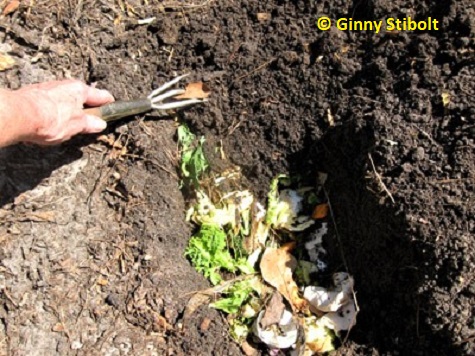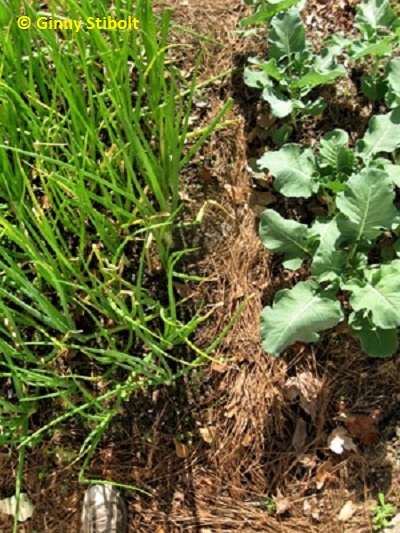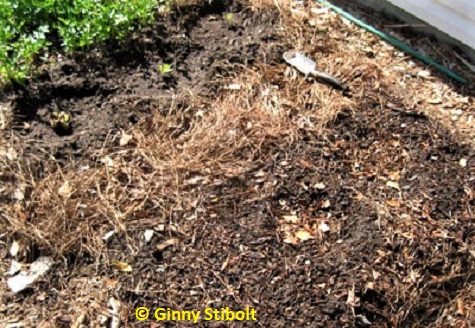Wide-row planting and trench
composting in the vegetable garden
By Ginny Stibolt
Composting is that magical process in which garden waste, water
weeds, kitchen scraps, dryer lint and other organic materials are
turned into a dark, nutrient-rich soil amendment that looks nothing
like the original materials. Microbes, those unseen soil inhabitants
including bacteria and fungi, do most of the work but worms and
other larger critters play roles as well.
 Kitchen
scraps enrich the soil in your garden beds--in situ composting.
>> Kitchen
scraps enrich the soil in your garden beds--in situ composting.
>>
I wrote an article Composting
for your garden, which continues to be one of my most visited articles.
I also included even more details about various ways to compost in Chapter
Three of my book. Since 2004, when we moved to northern Florida, we've
produced many huge piles of wonderful, rich compost. Our successful
vegetable crops over the years make the case for using compost alone
to fertilize crop plants.
In previous articles I've mentioned in broad terms that
trench composting can work in vegetable gardens, but now let's fill
in some details. The wide row planting arrangement that I use in most
of my vegetable beds is perfect for trench composting.
Wide row planting: the details
Wide row planting is one of the intensive growing arrangements
used to cram as much growing area in small spaces as possible. Square-foot
gardening is another popular intensive arrangements where you lay down
a one-foot grid over your garden and plant crops at just the right distance
from each other within each foot. Wide row planting is less rigid--rows
can be 6 to 20-inches wide with the plants spaced so they are just the
right distance apart. In between the rows is a 6-inch deep trench that
is 4 to 20-inches wide depending upon how much room the crop growing
in the adjacent rows will need. The rows are short (No more than five
feet long), so you can reach into the growing area without stepping
on the soil.
 The
trenches between the rows allow for water drainage during heavy rainstorms
and provide a little more space between the crops. Trenches should be
heavily mulched with easy-to-remove materials such as pine needles,
straw or dead leaves. Mulches such as sawdust or wood chips don't work
well for mulches where there is so much activity--they would be too
hard to rake away. I fill my trenches with pine needles as mulch right
up to the level of the planting surface to keep the weeds down.
There are lots of pine needles in our neighborhood, so this is a free
mulch for me. The
trenches between the rows allow for water drainage during heavy rainstorms
and provide a little more space between the crops. Trenches should be
heavily mulched with easy-to-remove materials such as pine needles,
straw or dead leaves. Mulches such as sawdust or wood chips don't work
well for mulches where there is so much activity--they would be too
hard to rake away. I fill my trenches with pine needles as mulch right
up to the level of the planting surface to keep the weeds down.
There are lots of pine needles in our neighborhood, so this is a free
mulch for me.
<< This wide row
planting has a 20-inch row on the left with sweet onions spaced four
inches apart and a 10-inch row with broccoli plants alternating down
the row. In between, the six-inch wide trench is filled with pine needles.
When the broccoli plants fill in you won't be able to see the trench
from this vantage point.
Trench composting: What, when and
where?
The term is descriptive of the process--you compost in
a trench. It is most often used by small vegetable gardeners within
their planting spaces, but well before any crop roots have reached the
area, because you don't want to damage the roots. So trench composting
is only useful when the crops are still small or as you're planting
the crops.
First remove the mulch, dig the trench another 4 or 5
inches deeper, lay in a 3-inch layer of kitchen scraps (no meat, bones
or oils), cover it with one or two inches of soil, and then replace
the mulch. You are not limited to kitchen scraps, you could also use
the remnants of your crops (as long as they are not diseased), grass
clippings or other green compost materials.
Transitions
Recently I transitioned between our cool-weather and warm-weather
crops--from lettuces and bunching onions to okra and peppers in one
area of the garden. The onions and the lettuces had been arranged into
three rows with narrow trenches. After I'd harvested the last of the
onions and pulled up the stubs of the lettuce plants, I raked away the
pine needle mulch (for reuse) and then dug in some finished compost
(from my big compost pile) to enrich the soil before planting the next
crops. I then rearranged the area into two rows (instead of three),
because the new crops will take more room. The trench between the rows
is wider, too.
I dug deeper between my new rows, laid in my kitchen scraps and covered them with soil,
gently tamped it down, and covered it all with pine needles. By the
time these new crops have roots long enough to reach the kitchen waste
deposit, it will be dark, rich compost filled with with macronutrients, nitrogen (N), potassium (K), and Phosphorus (P) and
many micronutrients,
particularly calcium, because of the eggshells.
 In
this photo, the trowel is lying over the trench, which is mulched with
pine needles, in the area where I'd buried the scraps shown in the lead
photo. This trench between the rows is about 10 inches wide. I
planted two okra seeds in each of the five holes in the wide row to
the right of this photo. The spacing between plants is supposed to be
12 inches. Note on the circles between where I planted the seeds: they
are shallow basins to make it easy to hand water the okra so the water
stays put and doesn't roll off the hill. Then I planted several
nasturtiums below the okra and next to the walkway. Nasturtiums are
in my edible garden for two reasons: 1) they'll attract pollinators
and 2) they're edible and their slightly peppery flowers and leaves
will grace many of our summer salads. And oh yes, they are beautiful! In
this photo, the trowel is lying over the trench, which is mulched with
pine needles, in the area where I'd buried the scraps shown in the lead
photo. This trench between the rows is about 10 inches wide. I
planted two okra seeds in each of the five holes in the wide row to
the right of this photo. The spacing between plants is supposed to be
12 inches. Note on the circles between where I planted the seeds: they
are shallow basins to make it easy to hand water the okra so the water
stays put and doesn't roll off the hill. Then I planted several
nasturtiums below the okra and next to the walkway. Nasturtiums are
in my edible garden for two reasons: 1) they'll attract pollinators
and 2) they're edible and their slightly peppery flowers and leaves
will grace many of our summer salads. And oh yes, they are beautiful!
I planted three bell pepper plants in other row--to the
left of the trowel. They have cardboard collars around them to keep
the cutworms at bay and soon I'll place three tomato cages over them
to keep them upright. There is no trench between the pepper row and
the parsley row. By the time the peppers get serious about growing in
the summer heat, the parsley will be gone. I'll just mulch over the
parsley row after their final harvest. I will not dig a new trench at
that time because the pepper roots will be in the area and I'll also
just cut off the parsley rather than pull it out so I don't disturb
the peppers. So now this part of my garden is arranged for the summer
and will be rearranged yet again in late fall to make way for the new
winter crops, but not lettuce and onions--I'll plant sugar snap peas
and carrots to complete my crop rotation.
Composting: a gardener's best tool
If you haven't done any composting yet, read Composting
for your garden, and you should be ready to try some trench composting,
too. You'll reap more and better-looking crops. I know you'll
love eating from your garden the way we do. Both you and your wallet
will be in better shape.
| 

 Kitchen
scraps enrich the soil in your garden beds--in situ composting.
>>
Kitchen
scraps enrich the soil in your garden beds--in situ composting.
>> The
trenches between the rows allow for water drainage during heavy rainstorms
and provide a little more space between the crops. Trenches should be
heavily mulched with easy-to-remove materials such as pine needles,
straw or dead leaves. Mulches such as sawdust or wood chips don't work
well for mulches where there is so much activity--they would be too
hard to rake away. I fill my trenches with pine needles as mulch right
up to the level of the planting surface to keep the weeds down.
There are lots of pine needles in our neighborhood, so this is a free
mulch for me.
The
trenches between the rows allow for water drainage during heavy rainstorms
and provide a little more space between the crops. Trenches should be
heavily mulched with easy-to-remove materials such as pine needles,
straw or dead leaves. Mulches such as sawdust or wood chips don't work
well for mulches where there is so much activity--they would be too
hard to rake away. I fill my trenches with pine needles as mulch right
up to the level of the planting surface to keep the weeds down.
There are lots of pine needles in our neighborhood, so this is a free
mulch for me. In
this photo, the trowel is lying over the trench, which is mulched with
pine needles, in the area where I'd buried the scraps shown in the lead
photo. This trench between the rows is about 10 inches wide. I
planted two okra seeds in each of the five holes in the wide row to
the right of this photo. The spacing between plants is supposed to be
12 inches. Note on the circles between where I planted the seeds: they
are shallow basins to make it easy to hand water the okra so the water
stays put and doesn't roll off the hill. Then I planted several
nasturtiums below the okra and next to the walkway. Nasturtiums are
in my edible garden for two reasons: 1) they'll attract pollinators
and 2) they're edible and their slightly peppery flowers and leaves
will grace many of our summer salads. And oh yes, they are beautiful!
In
this photo, the trowel is lying over the trench, which is mulched with
pine needles, in the area where I'd buried the scraps shown in the lead
photo. This trench between the rows is about 10 inches wide. I
planted two okra seeds in each of the five holes in the wide row to
the right of this photo. The spacing between plants is supposed to be
12 inches. Note on the circles between where I planted the seeds: they
are shallow basins to make it easy to hand water the okra so the water
stays put and doesn't roll off the hill. Then I planted several
nasturtiums below the okra and next to the walkway. Nasturtiums are
in my edible garden for two reasons: 1) they'll attract pollinators
and 2) they're edible and their slightly peppery flowers and leaves
will grace many of our summer salads. And oh yes, they are beautiful!